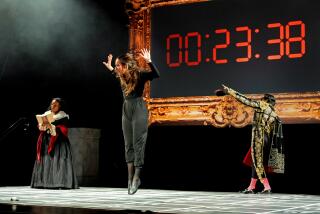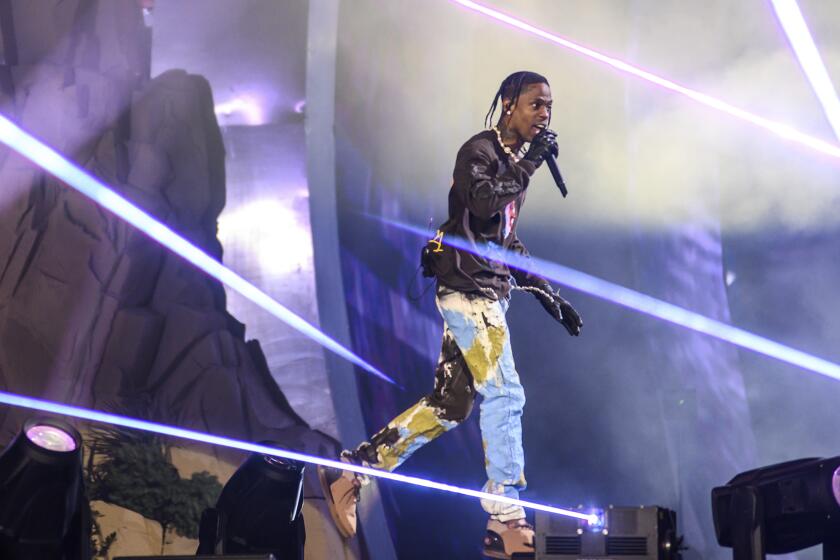Gone are the horned helmets in Wagner’s ‘Ring,’ but are new ways always better?
The horned helmet — usually sitting on the head of a zaftig soprano — is the universal symbol of Richard Wagner’s “The Ring of the Nibelung.” But like Shakespearean tights and codpieces, it’s a visual cliché that fell out of currency decades ago.
These days, radical is the new traditional when it comes to the “Ring.” Directors as diverse as Patrice Chéreau and Los Angeles Opera’s Achim Freyer have elicited praise and, in many cases, violent boos for their inventive stage interpretations of the Germanic saga.
As “Ring” veterans can attest, smashing an obsolete helmet is a high-risk undertaking that sometimes requires its own protective gear.
Case in point: L.A. Opera’s productions of the individual “Ring” operas have so far garnered generally positive reviews from critics but also many complaints from viewers. In online forums, they have described Freyer’s colorfully Brechtian staging — which emphasizes visual imagery over storytelling — as ugly, horrific, a disaster, a travesty, a scandal and “so bizarre that it reached a point of being insulting.” And that was just for “Das Rheingold,” the first installment of the four-opera cycle.
Harsh judgment is something adventurous directors have learned to expect from “Ring”-goers, who are among the most opinionated and vocal fans in all of opera. When asked about the public backlash against his “Ring,” Freyer shrugged his shoulders amiably and said, “An artist must do his work.”
Francesca Zambello, the international stage director who is mounting a new “Ring” at San Francisco Opera, said that she enjoys discourse with hard-core “Ring” fans and that “it’s healthy to have that kind of passion.”
Zambello’s interpretation of the “Ring” uses American historical iconography to tell Wagner’s story. The gods are portrayed as a Rockefeller-esque clan of bluebloods while the dragon that Siegfried slays is a large furnace-like device reminiscent of a locomotive engine. Her staging is a co-production with the Washington National Opera and the full cycle will open in San Francisco in 2011.
“Wagner wrote his ‘Ring’ cycle to be interpreted,” said Zambello on the phone from Paris, where she was working on another production. “He was one of the great interpretive artists himself. I think he would be happy with the way people keep reimagining his material.”
Productions of the “Ring” are typically placed in one of two categories: traditional or non-traditional. The former are often referred to pejoratively as “rags-and-rocks” for their use of literal imagery in which a sword is a sword and a shield is a shield.
Perhaps the best-known recent “traditional” production was Austrian director Otto Schenk’s staging at New York’s Metropolitan Opera. First seen in 1986, Schenk’s production was much beloved by audiences and ran for more than 20 years before being retired last season.
In the fall, the Met will begin rolling out its new “Ring” directed by Robert Lepage, the Canadian stage artist who is known for high-tech productions that involve advanced video technology and other digital effects. Details of Lepage’s “Ring” are scarce, but published reports state that the director was influenced by the topography of Iceland. Peter Gelb, the Met’s general manager, said in a statement that the new “Ring” will be “neither traditional or radical. It is an attempt to be true to the mythological story, using advanced theatrical techniques.”
When it comes to inventive “Ring” stagings, experts agree that ground zero is Chéreau’s 1976 Bayreuth Festival production that set Wagner’s story in the Industrial Revolution and focused on the psychological relationships between the characters. The production — which was commissioned by festival director Wolfgang Wagner (grandson of the composer) for the “Ring” centenary and was conducted by Pierre Boulez — featured a frank eroticism that surprised opera audiences at the time.
The Rhine maidens of “Das Rheingold” were portrayed as a trio of lusty prostitutes. In “Die Walküre,” the long-lost twins Siegmund and Sieglinde consummated their incestuous love with an intense scene, kissing and writhing passionately on the ground.
The Chéreau premiere was greeted with a mixture of praise and condemnation. One report (perhaps apocryphal) said that certain audience members reacted so violently that they tore the dress of Wolfgang Wagner’s wife, who was in attendance that evening.
Chéreau’s production, aired on PBS in the ‘80s, is available on DVD, as are a few other radical “Ring” productions from recent years.
Pierre Audi’s “Ring” for the Netherlands Opera in 1999 was notable for its unconventional placement of the orchestra on stage with the actors, going against Wagner’s preference for keeping the orchestra invisible in a masked pit. On the DVD, Audi explained that in scenes with two characters, the orchestra functions as a “third person.”
Kasper Bech Holten’s “Ring” for the Royal Danish Opera in Copenhagen in 2006 radically reinterpreted the story from a feminist point of view. The Valkyries were depicted as a rowdy bunch of suffragette-like flappers who sang the famous “Ride of the Valkyries” while drunk on champagne. The heroine Brünnhilde doesn’t die at the end of “Götterdämmerung” but instead lives to give birth to Siegfried’s child.
Perhaps the most high-tech “Ring” in recent memory was staged in Valencia, Spain, by the art collective La Fura dels Baus. The science-fiction production, conducted by Zubin Mehta, used advanced video technology to create a nearly nonstop parade of big-screen visual effects.
One prominent “Ring” (not yet on DVD) is Robert Wilson’s minimalist interpretation that has been staged in Zurich and Paris. The production features Wilson’s signature style — ultra-slow, almost zombified movement set against severely ascetic backdrops. Wilson’s “Ring” was not universally loved. One blogger for Le Monde noted the 16 hours of the production “seemed like 1,000 hours.”
Freyer’s “Ring” is a first for L.A. but not for Southern California. In 2006, Russia’s Kirov Opera presented its own complete staging at the Orange County Performing Arts Center.
The production, conducted by Valery Gergiev, drew visual inspiration from the folklore and mythology of Gergiev’s native South Ossetia region. Times music critic Mark Swed wasn’t entirely impressed, noting that the production seemed cobbled together after a partnership between the Kirov and a German theater team had fallen through.
Earlier the same year, Long Beach Opera staged an abridged “Ring,” created by Jonathan Dove, whose combined running time was 11 hours. “There’s some kind of holiness around Wagner saying that you can’t cut it,” said Andreas Mitisek, the company’s artistic director. “We had a lot of skeptics. Of course, you lose some of the sound but you gain in storytelling and the really intensified presence of who those characters are.”
With everyone going nontraditional, have rags-and-rocks productions finally become extinct?
“I don’t think it’s a thing of the past and nor do I think it needs to be,” said Christopher Koelsch, the head of artistic planning at L.A. Opera. “There’s always going to be audiences who expect the original intentions of the creators and who want to see a pictorial representation.”
More to Read
The biggest entertainment stories
Get our big stories about Hollywood, film, television, music, arts, culture and more right in your inbox as soon as they publish.
You may occasionally receive promotional content from the Los Angeles Times.







